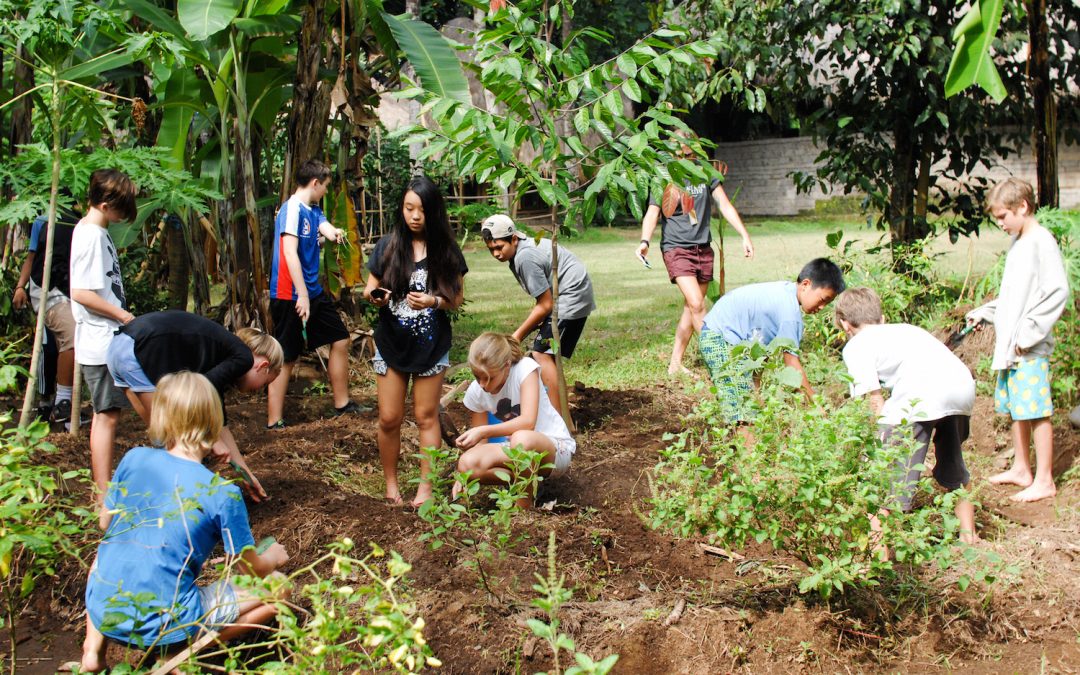No poverty. Zero hunger. Good health and well-being. Quality education. Gender equality. These are five of the seventeen Sustainable Development Goals (SDGs) that aim to make the world safer, fairer and more by 2030. Set at the United Nations Summit in 2015, it leaves less than ten months to accomplish each goal. While it can seem doubtful that any of these goals will be met in our lifetime, they more importantly serve as a map to guide us in the right direction towards a sustainable future. Now the question is, where do we start?
Green School’s Middle School Director Sal Gordon decided there was no better place to begin than with his ninety students. Instead of waiting until practicums or post-university to make a difference, Pak Sal incorporated the SDGs into the curriculum to teach students to seize every learning moment as an opportunity to make an impact.
In addition to more traditional proficiency subjects and experiential learning, Green School’s unique SDG Thematic programme provides opportunities for students to start their journey as informed, passionate, empathetic and creative thinking world changers. Thematics is delivered through project-based activities focused on each of the seventeen goals, and incorporates Global Awareness (humanities) and Science components in each. It’s broken up into six blocks over the year, exposing students to multiple issues, broadening their awareness of the goals.

Green School students stop to reflect on world water issues at the campus spring-fed pool
This past fall semester, the Sixth Grade covered Goal Six, clean water and sanitation. In the science component, students researched water-transmitted diseases and explored local and cultural water systems, from reverse osmosis to solar stills. They took personal, communal and global perspectives, considering their own effects on water cleanliness and looked at the major global issues related to our water crisis. Later in the semester they looked at how to use water as energy while covering Goal Seven, affordable and clean energy. The class worked together in different departments (logistics, laborers, engineers and foreman/forewomen) to build a dam with natural building materials on the bank of our adjacent Ayung River. The students revealed the impacts of dams by creating their own websites.

Students build their own dam on the banks of the Ayung River
Grade seven covered Goal 2 on ending hunger, achieving food security, and promoting sustainable agriculture, and Goal 3 on ensuring healthy lives and well-being. The units are designed with the Sustainability Compass model in mind – to encourage connections between Nature, Economy, Society and Wellbeing. So, the students delved into the topics from multiple directions and perspectives, from the physiology of hunger and GMO foods to how inequality impacts access to food.
In Grade Eight, students worked through economic ideas to approach Goal 1, ending poverty. They started by learning how wealth is created, the dangers of consumerism, and the psychology of poverty. Instead of leaving the students overwhelmed with the weight of these topics, they were then guided to research individuals and organizations that are alleviating poverty through purpose-driven projects. In the second block, they looked at Goal Four, equitable quality education and lifelong learning for all. The students learned about learning, discovering how the brain cognitively and morally develops over time. Then, they designed their dream schools, implementing a mission statement and curriculums that promote equity, inclusion and life-long learning.

Hands-on learning is a big part of the SDG-based Thematics programme
Through blocks like these, the students start to hone systems-thinking skills to better comprehend big picture concepts. Because Green School believes in local, community-based solutions, we also realize that we have responsibilities as citizens to our own communities. As Green School’s student population represents over 43 countries, we are a global community, and an ideal place to host a Model United Nations (MUN). But with such a driven group of student activists, it’s even more appropriate to be this incubator for solutions to meet the noble SDGs. During his visit two years ago for Green School’s Model UN, Secretary-General of the United Nations Ban Ki Moon mentioned, “this is the most unique and impressive school I have ever visited.” We have our creative faculty and driven students to thank for making such a lasting impression on Secretary General Moon, and for making an even greater impact on our students.
For lesson plans and ideas on how you can incorporate the SDGs into your curriculum, click here.

